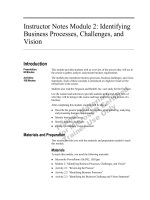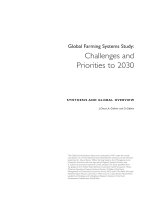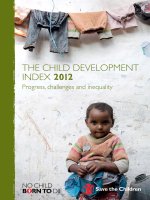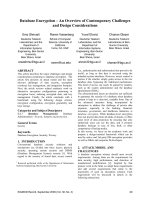Genomics driven-oncology: Challenges and perspectives
Bạn đang xem bản rút gọn của tài liệu. Xem và tải ngay bản đầy đủ của tài liệu tại đây (301.56 KB, 3 trang )
Normanno and Cree BMC Cancer (2015) 15:141
DOI 10.1186/s12885-015-1147-7
COMMENTARY
Open Access
Genomics driven-oncology: challenges and
perspectives
Nicola Normanno1* and Ian A Cree2
Please see related article: />
Abstract
Molecularly defined subgroups of tumors characterized by specific driver mutations have been identified in the
majority of cancers. The availability of novel drugs capable of targeting signaling pathways activated by genetic
derangements has led to hypothesize the possibility to treat patients based on their genomic profile. A clear
example is represented by lung adenocarcinoma for which it has been possible to identify driver genetic alterations
in approximately 75% of the cases. Among these, RET fusion transcripts are detectable in about 1–2% of lung
adenocarcinomas and might represent targets for therapeutic intervention with RET kinase inhibitors. However, a
number of issues need to be addressed to make genomics-driven oncology routinely accessible for cancer patients,
including: 1) the availability of novel methods in molecular diagnostics that allow a comprehensive molecular
characterization of lung tumors starting from a low input DNA/RNA; 2) identification of reliable and reproducible
biomarkers of response/resistance to targeted agents; 3) the assessment of the role of tumor heterogeneity in the
response to drugs targeting molecular pathways.
Keywords: Cancer genomics, Lung cancer, RET, Targeted therapy
Background
Somatic alterations of genes involved in the regulation
of cell proliferation, differentiation and survival play a
pivotal role in the pathogenesis and progression of the
majority of human cancers. In many cancer types it has
been possible to identify molecularly defined subgroups
of tumors that are characterized by driver mutations
(genetic alterations causally associated with carcinogenesis) that are often mutually exclusive [1]. An example is
represented by the adenocarcinoma subgroup of nonsmall-cell lung cancer (NSCLC), in which using high
throughput technology it has been possible to identify
driver genetic alterations in approximately 75% of the
cases [2].
The identification of such driver mutations and the
availability of novel drugs capable of targeting signaling
pathways activated by genetic derangements has led to
hypothesize the possibility to treat patients based on
their genomic profile (Table 1). An example of this
* Correspondence:
1
Cell Biology and Biotherapy Unit, Istituto Nazionale Tumori “Fondazione
Giovanni Pascale”, IRCCS, Napoli, Italy
Full list of author information is available at the end of the article
potential approach, defined genomics driven-oncology, is
represented by RET rearrangements in lung cancer [3].
Chimeric RET proteins generated by chromosomal rearrangements leading to RET fusion transcripts have been
identified in ~1–2% of lung adenocarcinomas but might
represent as many as 6–19% of tumors from neversmokers without other driver mutations [3]. Response to
treatment with RET inhibitors such as vandetanib or
cabozantinib has been reported in selected cases [4-7].
Phase 2 clinical trials of RET kinase inhibitors in lung
cancer patients harboring RET rearrangement are ongoing (Table 2). In this regard, a retrospective analysis of
RET translocations, gene copy number gains and expression from four randomized trials of vandetanib in NSCLC
is published in this issue of BMC Cancer [8]. Noteworthy,
this is the first series of patients from clinical trials that
have been extensively screened for RET molecular alterations, although retrospectively.
Discussion
While the absolute number of RET-positive tumors
reported in the paper by Platt et al. [8] is too low to
draw any firm conclusion, this study provides important
© 2015 Normanno and Cree; licensee BioMed Central. This is an Open Access article distributed under the terms of the
Creative Commons Attribution License ( which permits unrestricted use,
distribution, and reproduction in any medium, provided the original work is properly credited. The Creative Commons Public
Domain Dedication waiver ( applies to the data made available in this
article, unless otherwise stated.
Normanno and Cree BMC Cancer (2015) 15:141
Page 2 of 3
Table 1 Selected genetic alterations representing
potential biomarkers in lung adenocarcinoma and
related drugs in clinical development
Biomarker
Drug
EGFR mutations*
Gefitinib/Erlotinib/Afatinib
ALK rearrangements*
Crizotinib
ROS-1 rearrangements
Crizotinib
RET rearrangements
Cabozantinib/Vandetanib/Ponatinib
NTRK1 rearrangements
Cabozantinib
MET amplification
Crizotinib/Cabozantinib
NRAS mutations
Selumetinib/Trametinib
ErbB-2 mutations/amplification
Lapatinib/Trastuzuma/Afatinib
KRAS mutations
Selumetinib/Trametinib
BRAF V600E
Vemurafenib/Dabrafenib
BRAF Y472C
Dasatinib
*approved.
insights of critical discussion that can be generalized to
the entire field of genomics-driven oncology:
1. The rate of RET rearrangement in NSCLC was as
low as 0.7%, while previous studies have reported
frequencies up to 6%. RET rearrangements have
been suggested to be more frequent in Asian
patients, in non-smoker and in the adenocarcinoma
subgroup. Therefore, the selection of the study
population might significantly affect the frequency at
which RET rearrangements are detected. In addition,
RET rearrangement is usually mutually exclusive to
other driver mutations, and its frequency results
higher in patients that do not harbor the more
frequent KRAS and EGFR mutations [3].
Nevertheless, this observation poses a major
problem for molecular diagnostics that is common
to many cancer types. In fact, the number of potential predictive biomarkers that might offer possibility
of therapeutic intervention in lung cancer as well as
in other tumor types is increasing exponentially
(Table 1). Identification of driver mutations might
result in a survival advantage for cancer patients that
have access to novel drugs through clinical trials or,
in selected cases, to receive an off-label treatment
with agents approved for other indications [9].
However, the time, the cost, and the amount of
tissue needed for a wide molecular profiling using
routine diagnostic methods are not compatible with
the standard clinical workup, in particular in lung
cancer. In many European countries diagnosis of
lung cancer is based in over 50% of the cases on
cytology samples or small biopsies that might not be
sufficient for analysis of somatic mutations and gene
rearrangements in several different genes using
sequencing, Real Time PCR and/or FISH. Indeed, a
26.9% failure rate in FISH analysis due to an
inadequate number of tumor cells or sample quality
was reported by Platt and colleagues [8]. This
observation underlines the need for novel methods
in molecular diagnostics that allow a comprehensive
molecular characterization of lung tumors in the
routine clinical workout [10]. In this respect,
different methods to detect mutations and fusions
using genotyping or targeted next generation
sequencing are being explored, and might be
ready in a short timeframe for clinical
implementation [11-14].
2. Oncogenic pathways can be activated by different
molecular mechanisms. Indeed, Platt and colleagues
found RET amplification in 2.8% of the cases, low
RET gene copy number gain in 8.1%, and RET
protein expression in 8.3% [8]. Although the relative
low number of positive cases prevents any firm
conclusion, the finding that the response rate to
vandetanib did not correlate with any of these
markers does suggest that they have little predictive
utility to identify those patients who will benefit
from vandetanib therapy. This observation has two
important implications. First, activation of RET
through amplification or low copy number gain
might not represent a driver molecular alteration in
lung cancer. In addition, based on the data
presented in this issue of BMC Cancer by Platt et al.
[8], immunohistochemical detection of RET protein
is not a surrogate of RET rearrangement. In fact,
RET protein expression was found in cases that did
not harbor RET rearrangement. Surprisingly, no
RET protein expression was found in some cases
with RET rearrangement. This might be due to
technical limitations of the immunohistochemistry
protocol. Nevertheless, it might be worth to explore
whether protein expression levels might affect
Table 2 Phase II clinical trials of RET tyrosine kinase inhibitors in RET-rearranged lung carcinoma
Study identifier
Drug (dose)
Molecular targets
Primary outcome measure
NCT01639508
cabozantinib (60 mg/day)
MET, VEGFR2, FLT3, c-KIT, AXL and RET
ORR*
NCT01823068
vandetanib (300 mg/day)
VEGFR2, EGFR, RET and FGFR-1
ORR
NCT01813734
ponatinib (45 mg/day)
ABL, FLT3, KIT, FGFR, PDGFR, VEGFR2 and RET
ORR
*objective response rate.
Normanno and Cree BMC Cancer (2015) 15:141
response to RET inhibitors in patients with RET
rearranged lung tumors.
3. Only three RET-rearrangement positive patients
received vandetanib treatment in the trials reported
by Platt et al. [8], and this low number does not
allow to make any conclusion regarding association
of vandetanib treatment with efficacy in the RET
rearrangement positive subpopulation. However,
it is quite surprising that none of the three
vandetanib-treated RET-rearrangement-positive
patients had an objective response. Importantly, one
patient received a 100 mg dose of vandetanib in the
ZODIAC trial. Two patients were treated with the
standard 300 mg dose of vandetanib in the ZEPHYR
study, and both showed radiologic evidence of
tumor shrinkage although a response could not be
confirmed at the next visit. The ongoing phase 2
clinical trial of vandetanib in lung cancer patients
harboring RET rearrangement is employing a
300 mg dose and will clear out the efficacy of the
drug in this subgroup of patients (Table 2).
Nevertheless, we have come to expect that a tumor
harboring a driver mutation will respond to a
specific inhibitor, which was not the case in this
study. On the other hand, increasing evidence
suggests that tumors, including lung carcinoma, are
heterogeneous: many tumors contain several clones
of neoplastic cells that accumulate during tumor
progression different molecular alterations, which
might represent mechanisms of resistance to
target-based agents [15]. Therefore, it is possible
that even tumors with a driver mutation show
resistance to specific inhibitors. Indeed, the
response rate of lung cancer patients with EGFR
mutations to EGFR tyrosine kinase inhibitors ranged
between 56% and 86% in different clinical trials, thus
suggesting that primary resistance is a phenomenon
common to different tumors with driver mutations
[16]. In this regard, a more comprehensive
molecular characterization of lung tumors might
allow to better identify those patients that will
benefit from specific targeted agents.
Conclusion
Identification of relatively rare mutations is transforming
tumors with high incidence such as lung adenocarcinoma in some rare diseases, each characterized by a
specific molecular alteration. Molecular classification of
lung tumors based on driver mutations represents a
major challenge for molecular diagnostics, but also an
important opportunity for cancer patients to access to
novel drugs. In this regard, a number of issues need still
to be addressed to make genomics-driven oncology routinely accessible for cancer patients.
Page 3 of 3
Competing interests
The authors declare that they have no competing interests.
Authors’ contributions
NN and IAC prepared the main text, discussion and conclusion. Both authors
read and approved the final manuscript.
Acknowledgments
N. Normanno is supported by a grant from the Associazione Italiana per la
Ricerca sul Cancro (AIRC) - Grant number: IG12118.
Author details
1
Cell Biology and Biotherapy Unit, Istituto Nazionale Tumori “Fondazione
Giovanni Pascale”, IRCCS, Napoli, Italy. 2Department of Pathology, University
Hospital Coventry and Warwickshire, Coventry CV2 2DX, UK.
Received: 16 January 2015 Accepted: 27 February 2015
References
1. Garraway LA. Genomics-driven oncology: framework for an emerging
paradigm. J Clin Oncol. 2013;31(15):1806–14.
2. Network TCGAR. Comprehensive molecular profiling of lung
adenocarcinoma. Nature. 2014;511(7511):543–50.
3. Mulligan LM. RET revisited: expanding the oncogenic portfolio. Nat Rev
Cancer. 2014;14(3):173–86.
4. Drilon A, Wang L, Hasanovic A, Suehara Y, Lipson D, Stephens P, et al.
Response to Cabozantinib in patients with RET fusion-positive lung
adenocarcinomas. Cancer Discov. 2013;3(6):630–5.
5. Falchook GS, Ordonez NG, Bastida CC, Stephens PJ, Miller VA, Gaido L, et al.
Effect of the RET Inhibitor Vandetanib in a Patient With RET Fusion-Positive
Metastatic Non-Small-Cell Lung Cancer. J Clin Oncol 2014. [Epub ahead of print]
6. Gautschi O, Zander T, Keller FA, Strobel K, Hirschmann A, Aebi S, et al. A
patient with lung adenocarcinoma and RET fusion treated with vandetanib.
J Thorac Oncol. 2013;8(5):e43–4.
7. Mukhopadhyay S, Pennell NA, Ali SM, Ross JS, Ma PC, Velcheti V.
RET-Rearranged Lung Adenocarcinomas with Lymphangitic Spread,
Psammoma Bodies, and Clinical Responses to Cabozantinib. J Thorac Oncol.
2014;9(11):1714–9.
8. Platt A, Morten J, Ji Q, Elvin P, Womack C, Su X, et al. A retrospective
analysis of RET translocation, 1 gene copy number gain and expression in
NSCLC patients treated with vandetanib in four randomized Phase III
studies. BMC Cancer 2014.
9. Kris MG, Johnson BE, Berry LD, Kwiatkowski DJ, Iafrate AJ, Wistuba II, et al.
Using multiplexed assays of oncogenic drivers in lung cancers to select
targeted drugs. Jama. 2014;311(19):1998–2006.
10. Normanno N, Rachiglio AM, Roma C, Fenizia F, Esposito C, Pasquale R, et al.
Molecular diagnostics and personalized medicine in oncology: challenges
and opportunities. J Cell Biochem. 2013;114(3):514–24.
11. Lira ME, Choi YL, Lim SM, Deng S, Huang D, Ozeck M, et al. A single-tube
multiplexed assay for detecting ALK, ROS1, and RET fusions in lung cancer.
J Mol Diagn. 2014;16(2):229–43.
12. Magdaleno SM, Cheng A, Petraroli R, Sheils O, Tops B, Corre DL, et al.
Abstract 3575: The OncoNetwork Consortium: A global collaborative
research study on the development and verification of an Ion AmpliSeq
RNA gene lung fusion panel. Cancer Res. 2014;74:3575.
13. Ciardiello F, Normanno N, Maiello E, Martinelli E, Troiani T, Pisconti S, et al.
Clinical activity of FOLFIRI plus cetuximab according to extended gene
mutation status by next-generation sequencing: findings from the
CAPRI-GOIM trial. Ann Oncol. 2014;25(9):1756–61.
14. Scarpa A, Sikora K, Fassan M, Rachiglio AM, Cappellesso R, Antonello D,
et al. Molecular typing of lung adenocarcinoma on cytological samples
using a multigene next generation sequencing panel. PLoS One.
2013;8(11):e80478.
15. Burrell RA, McGranahan N, Bartek J, Swanton C. The causes and
consequences of genetic heterogeneity in cancer evolution. Nature.
2013;501(7467):338–45.
16. Rossi A, Pasquale R, Esposito C, Normanno N. Should epidermal growth
factor receptor tyrosine kinase inhibitors be considered ideal drugs for the
treatment of selected advanced non-small cell lung cancer patients? Cancer
Treat Rev. 2013;39(5):489–97.









